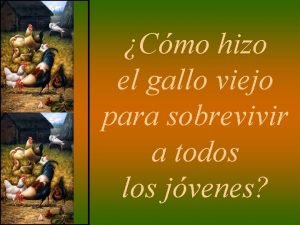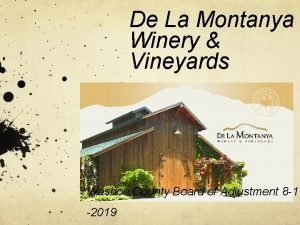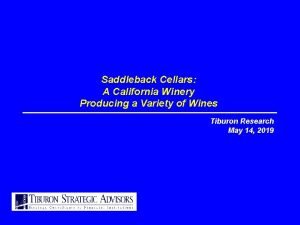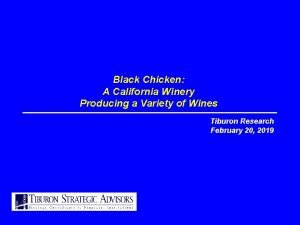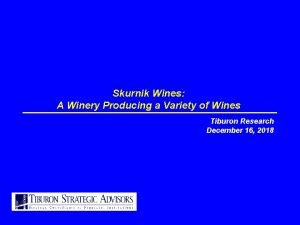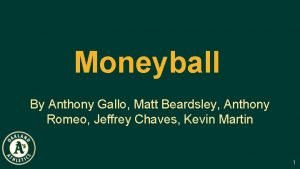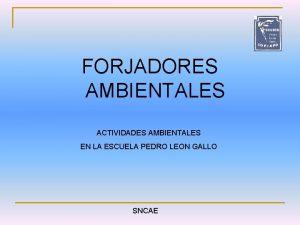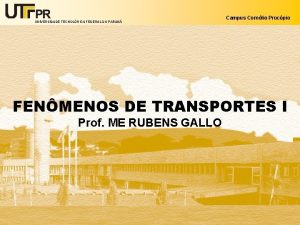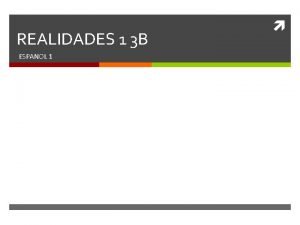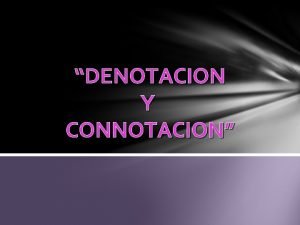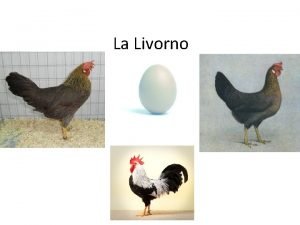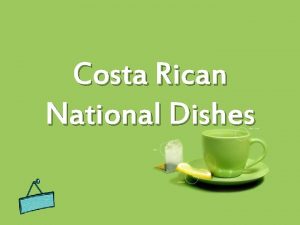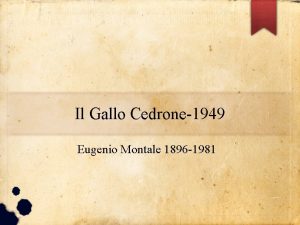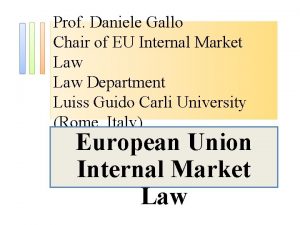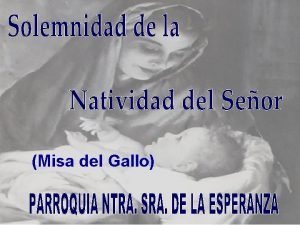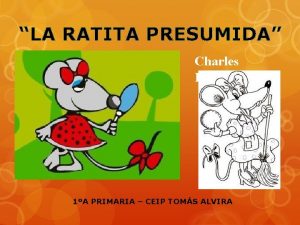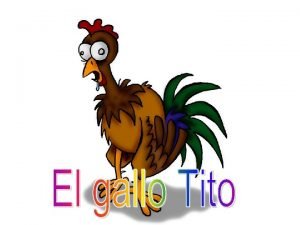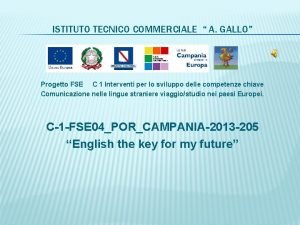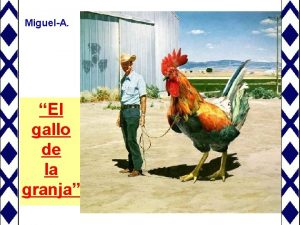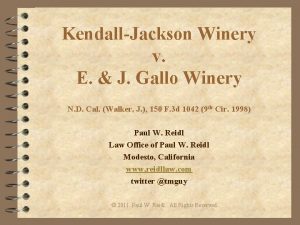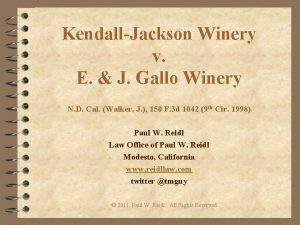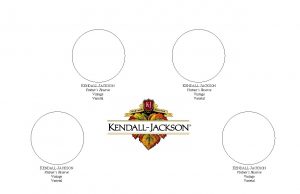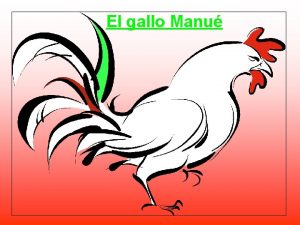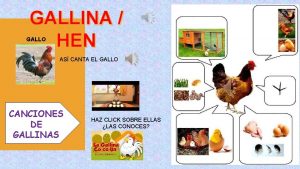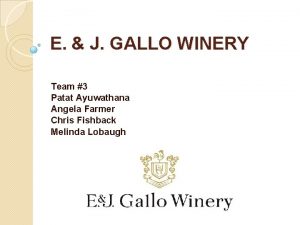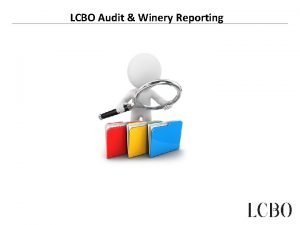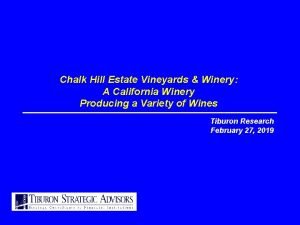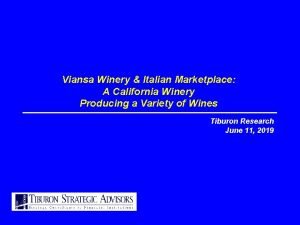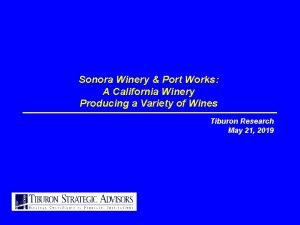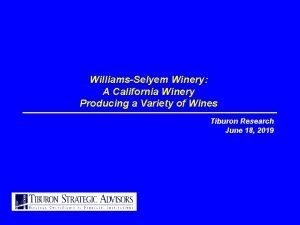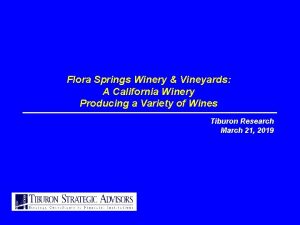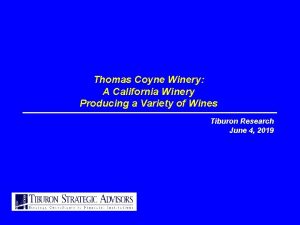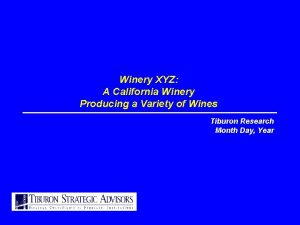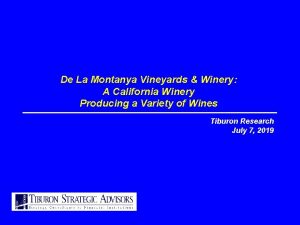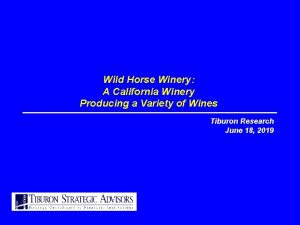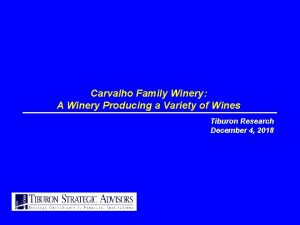KendallJackson Winery v E J Gallo Winery N










































- Slides: 42

Kendall-Jackson Winery v. E. & J. Gallo Winery N. D. Cal. (Walker, J. ), 150 F. 3 d 1042 (9 th Cir. 1998) Paul W. Reidl Law Office of Paul W. Reidl Half Moon Bay, CA www. reidllaw. com twitter @tmguy © 2014. Paul W. Reidl. All Rights Reserved.

STRAW POLL? © 2014. Paul W. Reidl.

HISTORICAL PERSPECTIVE: A Clash of Titans Ø This was in many respects a precedent-setting case in the Ninth Circuit; pushed the boundaries of trade dress law. Two Pesos had been decided only a few years earlier. Ø Bitterly fought; highly publicized; settlement was out of the question. Ø Huge amount of “behind the scenes” intrigue including at the courthouse. © 2014. Paul W. Reidl. .

OBJECTIVES FOR TODAY Ø Use this case to illustrate how trade dress concepts play out in the enforcement context. Ø While there was a winner and a loser, we are not going to discuss who was “right” or “wrong; ” rather we are going to focus on the tactical and strategic decisions. Ø Please ask questions. (C) 2014. Paul W. Reidl.

THE COMPLAINT Ø The Complaint focused on the trademark claim based on the leaf design and the allegation that infringing the leaf trademark was intentional. Ø The trade dress claim was almost an afterthought. (C) 2014. Paul W. Reidl.

TRADEMARK ISSUE (C) 2014. Paul W. Reidl.

TRADE DRESS ALLEGATIONS Ø Extremely vague. Ø Inherently distinctive; secondary meaning; non-functional. Ø Did not specify the elements of the trade dress that it claimed were protected. © 2014. Paul W. Reidl.

DEFENSE CONUNDRUM Ø Without knowing what the Plaintiff claimed was protected, the Defendant could not attack the claimed elements of the trade dress as functional or not inherently distinctive. Ø The strategy was to “divide and conquer” by showing that the Plaintiff had nothing to protect and what they were claiming was functional anyway. © 2014. Paul W. Reidl.

MOTION TO DISMISS Ø The Defendant argued that the Plaintiff was playing “hide the ball” and had failed to state a claim. Ø It is lawful to copy that which is not protected, so Defendant needed to know what the Plaintiff claimed it owned. Otherwise, any wine bottle could be inherently distinctive and non-functional. Ø The Defendant also needed the information so that it could determine whether the trade dress was inherently distinctive and functional. Ø Did not believe that the motion had much chance of success but needed to smoke out the Plaintiff. © 2014. Paul W. Reidl.

“TOUT ENSEMBLE” Ø The Plaintiff’s argument was elegant in its simplicity and very troubling; all they had to do was to hold up the two bottles and they could win. “We are the only one that looks like this; therefore, it is inherently distinctive. Obviously the entire package cannot be functional. Therefore, the only question is likely confusion. ” © 2014. Paul W. Reidl.

“TOUT ENSEMBLE” v. ELEMENTS Ø This illustrated the competing views of the case that permeated the litigation, and perhaps most trade dress cases. Ø If you are required to look at trade dress “as a whole, ” is proof of inherent distinctiveness and non-functionality really needed? Is it proper for the defense to break the claimed trade dress into its constituent parts for analytical purposes? And if not, is it (as Plaintiff asserted) solely a matter of whethere was a likelihood of confusion? © 2014. Paul W. Reidl.

DECISION Ø The Judge denied the motion but waffled on the core issue. Ø He required the Plaintiff to specify the elements of its trade dress that were allegedly protectable and non-functional. Ø From his perspective, this was the right call; since the Defendant was not clearly wrong, let it pursue the defense and see what happened. © 2014. Paul W. Reidl.

TRADE DRESS ELEMENTS Ø Burgundy/Bordeaux style bottle Ø Flanged Top Ø Cigar Band Wrapper Ø White label Ø Grape Leaf © 2014. Paul W. Reidl.

DEFENSE PLAN Ø Make the argument that individually, none of these elements was protectable so, therefore, they could not be protected collectively or “tout ensemble. ” Ø 0 + 0 + 0 = 0. It can never equal 1, in part, because there was nothing unique about the way they were combined by the Plaintiff. © 2014. Paul W. Reidl.

ATACKING THE ELEMENTS Ø Burgundy/Bordeaux style bottle – D’uh, no one can own the industry standard bottles. Generic and functional; incapable of serving as an indicator of source. © 2014. Paul W. Reidl.

ATTACKING THE ELEMENTS Ø Flanged Top – Had been used for many years; Robert Mondavi Winery had tried to register it and failed; functional because it stops drips. © 2014. Paul W. Reidl.

ATTACKING THE ELEMENTS Ø Cigar Band Wrapper – was not a source identifier per se but a platform for branding; functional because it covers the space between the fill line and the cork; all flanged bottles had it; using the standard foil wrapper was impractical due to the flange. © 2014. Paul W. Reidl.

ATTACKING THE ELEMENTS Ø White label – incapable of acting as an indicator of source; functional because it is the best palette for a wine label. © 2014. Paul W. Reidl.

ATTACKING THE ELEMENTS Ø And so it all boiled down to the grape leaf; hundreds of bottles have grape leaves on the label; nothing unique about that; necessary to compete. © 2014. Paul W. Reidl.

ATTACKING THE ELEMENTS Ø The Plaintiff’s witnesses admitted all of this, but from the Plaintiff’s standpoint it was all irrelevant. In fact, in their discovery on the trade dress claim was an afterthought. Ø The Plaintiff had an expert (retired TTAB Judge) who opined on inherent distinctiveness but his primary role was attacking the “advice of counsel” defense. © 2014. Paul W. Reidl.

SUMMARY JUDGMENT Ø Trademark. The Plaintiff did not prove that the leaf functioned as a trademark separate and apart from the KJ crest. Defendant’s motion granted. Ø Trade Dress. A reasonable jury could find, based on tout ensemble, that 0+0+0 could equal 1 due primarily to the “distinctive leaf, ” so the motion was denied, i. e. , if the jury believed that leaf was distinctive, then it could find that the packaging “on the whole” was distinctive and nonfunctional. © 2014. Paul W. Reidl.

SUMMARY JUDGMENT “Dr. Jekyll and Mr. Hyde” Ø Yes, the two portions of the decision were mutually exclusive. As a result both parties filed motions for reconsideration which were denied. Ø And so, the leaf was not distinctive for trademark purposes but was distinctive for trade dress purposes and could be the sole basis for a verdict on the trade dress claim. © 2014. Paul W. Reidl.

SUMMARY JUDGMENT Ø Stated somewhat differently, according to the Judge, a symbol that was not inherently distinctive could be the sole basis for finding the trade dress inherently distinctive. Ø This meant that we were going to try the trademark case under the guise of a trade dress case but under a lower standard of proof; from the Plaintiff’s standpoint it was all about the leaf anyway. © 2014. Paul W. Reidl.

TRIAL STRATEGY Ø Breaking the trade dress into its component parts was too “down in the weeds” for a jury. Needed to do it for record purposes but it could not be theme. Needed a unifying trial theme as to why the claimed trade dress was not inherently distinctive and was functional. © 2014. Paul W. Reidl.

TRIAL STRATEGY Ø Enter - - “THE CALIFORNIA LOOK. ” Ø “This is the way California wines look and Plaintiff did not originate it. Tout ensemble functioned to tell consumers that this was a California table wine. They had nothing to protect. ” © 2014. Paul W. Reidl.

PLAINTIFF’S CASE Ø Over the objection of the defense, the Plaintiff tried the “leaf” case, so the trade dress case morphed into a trial about the leaf and the allegations of copying it. Ø Plaintiff’s expert witness opined (over the objection of the defense) that the trade dress was inherently distinctive and nonfunctional. Destroyed on cross so his testimony hurt Plaintiff. © 2014. Paul W. Reidl.

TRIAL DEFENSE Ø 25 bottles of similar looking wines in the courtroom at all times. Ø Cross examination of the Plaintiff’s witnesses on the trade dress elements; all admitted. Ø Testimony of Michael Mondavi on their use of the flanged bottle and leaves on labels. Ø Client testimony on the “California Look” and why this was necessary to compete. Ø (There was also extensive survey expert testimony. ) © 2014. Paul W. Reidl.

JURY INSTRUCTION (Civil Instruction 15. 2) Ø “Trade dress is the non-functional physical detail and design of a product or its packaging, which [indicates] [or] [identifies] the product’s source and distinguishes it from the products of others. ” Ø “Trade dress is the product’s total image and overall appearance, and may include features such as size, shape, color combinations, texture, or graphics. In other words, trade dress is the form in which a person presents a product or service to the market, its manner of display. ” © 2014. Paul W. Reidl.

JURY INSTRUCTION (Civil Instruction 15. 2) Ø “A trade dress is non-functional if, taken as a whole, the collection of trade dress elements [is not essential to the product’s use or purpose] [or] [does not affect the cost or quality of the product] even though certain particular elements of the trade dress may be functional. ” Ø 15. 6: Plaintiff has the burden of proof on distinctiveness, ownership and non-functionality. © 2014. Paul W. Reidl.

JURY VERDICT FORM Ø The parties wanted a jury verdict form on each element of the trade dress claim. That was refused. Ø The Judge gave the jury the single question: was there infringement? © 2014. Paul W. Reidl.

VERDICT Ø No infringement. Ø Juror interviews: they did not believe that Plaintiff had anything to protect; this was the “California Look. ” “Look at all the similar bottles in the courtroom. ” Plaintiff overpromised and under-delivered on the copying argument. © 2014. Paul W. Reidl.

PLAINTIFF’S MOTION Ø As a matter of law, there was no evidence to support a jury verdict that the trade dress was functional and not inherently distinctive. In other words, the Judge should find based on tout ensemble that the jury could not have reached the verdict it did; should have been instructed on this. Ø Defense: yes there was enough evidence, but there was ample evidence to find no confusion so any error was harmless. © 2014. Paul W. Reidl.

DECISION Ø Motion denied. Ø By this point, having heard the evidence, the Judge understood and agreed with the defense. He found for the defense on the state law claims and on laches. © 2014. Paul W. Reidl.

NINTH CIRCUIT DECISION Ø Affirmed. 150 F. 3 d 1042 (9 th Cir. 1998) Ø Foreshadowed at oral argument when Judge Choy asked to see the bottles and remarked: “These don’t look similar at all. ” © 2014. Paul W. Reidl.

NINTH CIRCUIT DECISION Ø Plaintiff was correct on the law: the question is whether the packaging as a whole was nonfunctional and inherently distinctive. Ø The jury could have found for Plaintiff based on its evidence but judgment for Plaintiff as a matter of law was unwarranted. Ø There was sufficient evidence for a reasonable jury to find that the California Look (the trade dress as a whole) was functional. © 2014. Paul W. Reidl.

NINTH CIRCUIT DECISION “Gallo's evidence also showed that the combination of an exposed cork, a rounded flange, and a neck label create the "California look, " which consumers come to expect from a California wine…. A reasonable jury could conclude from this evidence that Kendall. Jackson's trade dress as a whole is functional and nondistinctive. ” © 2014. Paul W. Reidl.

NINTH CIRCUIT DECISION “For instance, a reasonable jury could conclude that these features — an exposed cork, a rounded flange, and a neck label — constitute a significant part of Kendall. Jackson's trade dress and that granting Kendall -Jackson exclusive use of this combination of features would put competitors at a significant non-reputation-related disadvantage. ” © 2014. Paul W. Reidl.

HOISTED ON THEIR OWN PETARD “Likewise, a jury could conclude from this evidence that the "California-look" tells consumers what the product is or at least describes a characteristic of the product, namely that it is wine from California. This conclusion would support a finding that the trade dress was generic or descriptive and therefore nondistinctive. The fact that Kendall-Jackson's grape-leaf design is distinctive does not necessarily mean that the entire trade dress is distinctive because, as Kendall-Jackson itself emphasizes, trade dress must be analyzed as a whole. ” © 2014. Paul W. Reidl.

ASSESSMENT Ø Plaintiff was correct about the “tout ensemble” approach to the law. Ø Defendant’s strategy of breaking the trade dress into component parts was also affirmed because it provided the basis on which the jury could conclude that tout ensemble was not protectable or functional. Ø Most notably, the Court held that Plaintiff was not entitled to judgment as a matter of law on the protectability of its trade dress. © 2014. Paul W. Reidl.

IMPLICATIONS Ø Taken literally, the Ninth Circuit said that a party can get to a jury on the tout ensemble theory. Ø In the wine and beverage area, the case is still a template for how to approach these issues. Ø The brand name seems to be relevant only to the actual confusion element, yet this is (and is intended to be) the most distinctive element of the packaging because most competitive packaging is similar. © 2014. Paul W. Reidl.

IMPLICATIONS Ø At the end of the day, this case raises more questions than it answers about how to deal with these claims. Ø One wonders whether it is even worthwhile trying to prove lack of distinctiveness and functionality, or should the effort focus on actual confusion? A risky approach because for competitive products the rest of the Sleekcraft factors are likely to weigh in plaintiff’s favor which would reduce the case to dueling surveys. © 2014. Paul W. Reidl.

Thank You! 241 Eagle Trace Drive Half Moon Bay, California 94019 (650) 560 -8530 reidl@sbcglobal. net Twitter @ tmguy www. reidllaw. com © 2014. Paul W. Reidl.
 El gallo viejo y el gallo joven
El gallo viejo y el gallo joven De la montanya winery
De la montanya winery Saddleback winery
Saddleback winery Black chicken winery
Black chicken winery Winery organizational chart
Winery organizational chart Culmina winery
Culmina winery Lorenza gallo
Lorenza gallo Ej gallo sales leadership development program
Ej gallo sales leadership development program Romeo gallo
Romeo gallo Kikirikí estoy aquí decía el gallo colibrí
Kikirikí estoy aquí decía el gallo colibrí Escuela pedro leon gallo
Escuela pedro leon gallo Rubens gallo
Rubens gallo Canta el gallo con el kirikiri
Canta el gallo con el kirikiri Ahi nos vidrios significado
Ahi nos vidrios significado Livorno collo arancio
Livorno collo arancio Gallo records manager
Gallo records manager Picadillo de arracache
Picadillo de arracache Il gallo cedrone montale
Il gallo cedrone montale Daniele gallo luiss
Daniele gallo luiss Lectura de la misa del gallo
Lectura de la misa del gallo Oraciones con presumido
Oraciones con presumido Un granjero tiene gallos y caballos
Un granjero tiene gallos y caballos Itc gallo
Itc gallo Suelta un gallo
Suelta un gallo Gallo
Gallo
